Time machines do exist. They are called motorcycles.
Like this 2022 BMW R18 Transcontinental, for instance. It’s brand-new – but it could be 1932.
Until you look closer at it.
So . . . let’s have a look!
What It Is
The R18 T – for Transcontinental – is an all-the-bells-and-whistles touring version of the R18 retro-cruiser that BMW Motorrad (the motorcycle division of BMW) launched in 2020 that pays tribute to the classic boxer BMW bikes of the past.
It’s equipped with a modified version of the standard R18s’ tube steel frame, a larger tank and a full complement of cross-country/all-weather amenities, including a heated/back-and-arm-rested passenger throne, triple storage hard bags form-fitted to the bike, high-mount windshield and air deflectors, a Marshall audio system and a 10.25 inch color display monitor with left-grip rotary/push knob controller for the seat and grip heaters, navigation, adjustable ride modes, adaptive cruise control, integrated hands-free comms – and other such.
But the heart of every R18 is the Big Boxer – the air-cooled, two-cylinder, overhead valve (not cams) engine that powers this retro-new BMW and its siblings.
If it looks familiar, look closer.
Each of those jugs displaces a touch more than 900 cubic centimeters- for 1802 of them, all told. That’s almost the same size as the inline 2.0 liter (2000 cc) four cylinder engines that BMW installs in many of its new cars.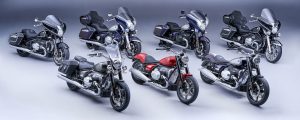
Base price is $24,995.
The tested First Edition with extra chrome trim and classic gloss black finish with white pinstripes plus the Premium and Select packages – which adds an adaptive (turns with the curves) headlight, Reverse Assist, Hill Start Control, keyless locking fuel cap and central locking/anti-theft system – stickered for $31,695.
What’s New
The Transcontinental is the latest iteration of and addition to the the R18 line of heavyweight cruising/touring/bagger bikes.
What’s Good
Iconic engine – just a lot bigger.
Work of art exposed (and nickel-plated) shaft drive.
Optional reverse-assist isn’t necessarily necessary thanks to low seat height (29.1 inches) that makes it easier to push back Fred Flintstone-style.
What’s Not So Good
Big boxer’s side-mounted air intakes can be obstructive to foot controls
Make sure passenger’s shoelaces aren’t dangling.
Make sure you can handle it before you ride it.
It’s a mark of the times that BMW’s bikes come with bigger engines – proportionately as well as almost-actually – than BMW’s cars.
Because the time hasn’t yet come for bikes.
It is still 1990 or so, as regards them. As regards the regulations – especially regarding emissions , Which apply less to them. It is why BMW Motorrad can “get away” with building an air-cooled engine for its new bikes while no one – not even Porsche – can still install one in a new car.
It’s not that air-cooled engines befoul the air. It is merely that they cannot comply with the regs – as they apply to cars – because it is harder to control the temperature variation of an air-cooled engine than a water-cooled one. The difference in actual emissions is trivial – but it is determinative as far as what’s allowed.
No fins for you – as the Soup Nazi used to say.
Unless it’s a bike.
These fins are functional.
So are the chromed pushrod tubes extending from the side of the case to the heads – where there are four valves (as opposed to the usual two) controlling the flow of air into this big boxer. How big is it? Each 900 cc jug is equivalent in displacement to all four cylinders powering this writer’s 1976 Kawasaki Kz900. Which – back in the ‘70s – was one of the biggest-engined bikes on the road.
Because it is so big, there’s an additional main center bearing in the case – and an extra-large flywheel, to smooth it all out. 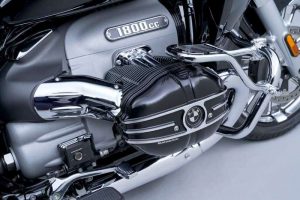
And because there’s no radiator – and because the heads are exposed – adjusting valve clearance doesn’t require disassembling half the bike or even any of it to get at it. This being one of the many practical benefits of the air-cooled/boxer layout.
Output is 91 horsepower at 4,750 RPM and 116 ft.-lbs. of torque at 3,000 – with almost all of that (111 ft.-lbs.) available from 2,000-4,000 RPM. This makes shifting the six speed transmission almost optional.
Shaft drive is standard – which isn’t unusual. What’s unexpected is that the shaft is gorgeously exposed (and deeply nickel-plated). The shaft connects to an equally visible and just-as-lavishly plated U-joint, just ahead of the rear wheel.
Also per retro, the BMW’s engine and transmission have their own separate sumps, with a dry rather than wet clutch.
The tank in this rig holds 6.3 gallons of fuel – which greatly increases the range-without-stops of this asphalt Valkryie.
You can go about 250 miles – about as far as most cars.
Just a lot more enjoyable.
This bike weighs some 941 pounds just standing there – so well over 1,000 with the rider in the saddle and closer to 1,300 with two average size people on board.
It’s a lot to push.
But it’s manageable, in part because of the 29.1 inch seat height and the position of the rider relative to the handlebars. The main challenge is standing the behemoth upright, which takes some muscle, because of the sexy rake BMW dialed in when the thing is parked on its side stand.
Once you’ve heaved it upright, you’ll probably be able to back up using foot power.
If you need an assist, BMW offers reverse.
This is engaged via a toggle to your left, just below the seat. The default position is F – for Forward. If you need to reverse, toggle to R – then wait for the dash to display R. Now push the engine start button and the starter motor will back you up.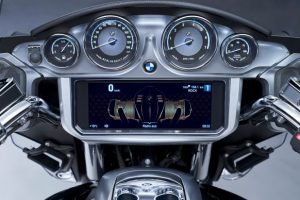
The enormous boxer engine just ahead of your legs looks as large as the Titanic’s reciprocating engines. It is a little intimidating at first – in a good way. Like that first date with someone who might be just a little out of your league.
Push the button and a concatenation of combustion follows – immediately. BMW has fitted an appropriately mighty starter to this beast that is capable of rotating all of that mass seemingly instantaneously. This boxer doesn’t crank.
It erupts.
And the sound it makes is both unique – and special.
Unique in that no other type of engine sounds like a big boxer engine. V-twins do their thing. This one does something different. It’s not necessarily better; that is a matter of taste. The point is it’s not the same – as is becoming depressingly descriptive of car engines.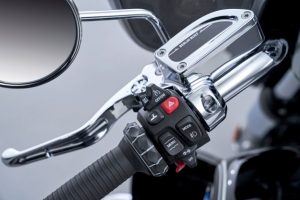
It is special, in that you can hear everything. Not just the exhaust note it makes.
The mechanical music of an air-cooled engine isn’t muffled by water jackets. You can discern by ear the action of the pushrods, the light happy ticking-clatter of the valves, when cold, until the growing warmth tightens up the clearances. You are literally, physically, closer to the workings of an air-cooled engine and the effect is much magnified when the engine is a boxer engine and the jugs are hanging in the breeze rather than hiding under the tank.
Rotate the throttle and feel the torque – again, literally. The massive engine rotates the bike, left-right – in syncopation with the action of your wrist on the grip. It’s exciting and just a little bit wonderfully scary.
Are you ready?
Select either – or Rain, the third of the available drive modes, which you can access and select via the control adjacent to the left grip. Each alters throttle tip-in, power delivery and degree of slip allowed (via the ASR stability control) to suit those moods – and conditions.
Regardless, the power delivered is Clydesdalian. Once up to 30 or so MPH, shifting becomes something you do because you feel like it. Third – or sixth – either will keep you rolling without struggling. This not necessarily having to shift is a good thing given that shifting this thing quickly can be challenging if your left foot isn’t pre-positioned to work the shifter. Which is mounted fairly tight against the bike’s frame and just below the enormous intake runner feeding air to the big twin’s left jug.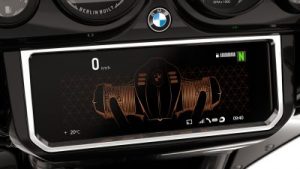
The rear/heel shifter is better-positioned – but it’s for upshifts. If you need to go down, you must use your toe – and sometimes I found mine trying to find the forward control. It gets easier as you get used to it but depending on your leg length/foot size (and shoe/boot size) you may want to make some minor adjustments to improve the accessibility – and the action.
That is all I can report regarding anything less than stellar about riding this bike.
Wind protection doesn’t look like much but is exceptional. BMW Motorrad clearly spent a lot of effort wind-tunneling the deflectors, which do their job brilliantly. The heated grips and seats will cook you if left on the highest setting (5). Dial it down to 3 and you’ll be toasty warm even if you’re not wearing a heated suit.
This bike is not as fast as my actually retro ’76 Kz900 Kaw – which could reach 140 MPH . . . if you dared. The R18 T’s top speed is electronically limited to 111 MPH, but unlike my old Kaw, this bike can handle it. Can stop from it. Huge dual 300 mm discs and four piston calipers up front with a single 300 mm disc in back provide effortless, confident deceleration at any speed. The front and rear brakes are linked and ABS is standard, with braking force automatically leveraged front-to-rear when applied, even if the rider doesn’t actually apply both together, manually.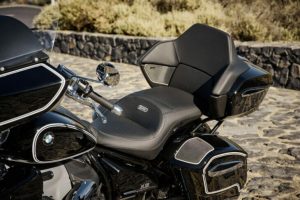
The bike’s considerable weight is brilliantly controlled by the suitably huge (49 mm) forks – clad in stainless steel – and retro-traditional BMW cantilever-type rear suspension system, augmented by electronically-controlled damping and load compensation that automatically maintains the bike’s ride height.
Though marketed as a long-distance luxury-touring motorcycle, this is a BMW motorcycle and as such can cut the rug, if you feel the urge. It is more athletic-feeling than other full-dresser/touring bikes I’ve ridden, excepting perhaps the Honda Goldwing. The latter is also a superlative bike but also a very different type of bike. Neither is necessarily better, just different.
Which is excellent.
Speaking of that.
The R18’s form – like its function – is like nothing else.
There are several other bikes in this class – including the ‘Wing, the Indian Chieftan and (of course) the various big Harleys. But you cannot mistake any of these for any of the others – and that is why people are still passionate about bikes and less so about cars. Which are distinguishable one from the other mostly in terms of their badges, their engines and appearances being almost invariably the same.
Specific to the form of this bike are the already-discussed boxer powerplant, its industrial art exposed shaft drive (watch those loose shoelaces!) and the distinctly BMW shapes of the tank and fairings, as well as the rake of its tubular steel frame.
This version of the R18 does not have the retro-30’s fishtail exhaust tips that are used with the unfaired R18 Classic. Instead, more traditional low-mount pipes. There are also case guards and different casting/plating finishes, one vs. the other.
BMW offers several palette options, including a voluptuous color-shifting scheme style Galaxy Dust Metallic with the iridescent turquoise blue-purple sheen of a strutting peacock. But I think classic black with twin white pinstriping that adorns the First Edition suits the T . . . to a “T.”
It’s 1932 meets 2022.
Among the standard array of analog gauges – in addition to the speedometer, fuel and tach – is a Reserve Power gauge that lets you know how much of the big boxer’s power you’re not using. It’s an interestingly different take on the more commonplace real-time horsepower and torque displays.
Keyless ignition is standard – a modern feature of new cars that arguably makes more sense for a bike. No having to fish through the pockets of your riding suit to find the keys – to unlock the tank – or the bags.
Below the retro-traditional analog instruments is the modern 10.25 inch screen that digitally displays the various electronically adjustable features, which you select/toggle through using the roll/push wheel on the left grip. This has a learning curve – you have to train yourself to remember whether it’s roll up – or drown – and when to push to select (also up or down) but memory muscle builds within a day or two of riding the bike and after that becomes second nature.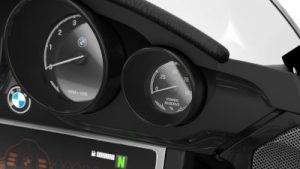
Like other long-distance-capable bikes, this bike has lots of storage space (27 liters) for the things you’ll want to bring along when you’re hundreds of miles from home.
Which you’ll probably want to be – often – if you decide to ride one of these home.
The Bottom Line
If you’re depressed about the state of cars – and want a trip back to a better time – BMW has just the machine you’re looking for.
. . .
Got a question about cars, bikes, Libertarian politics – or anything else? Click on the “ask Eric” link and send ’em in! Or email me at [email protected] if the @!** “ask Eric” button doesn’t work!
If you like what you’ve found here please consider supporting EPautos.
We depend on you to keep the wheels turning!
Our donate button is here.
If you prefer not to use PayPal, our mailing address is:
EPautos
721 Hummingbird Lane SE
Copper Hill, VA 24079
PS: Get an EPautos magnet or sticker or coaster in return for a $20 or more one-time donation or a $10 or more monthly recurring donation. (Please be sure to tell us you want a magnet or sticker or coaster – and also, provide an address, so we know where to mail the thing!)
My eBook about car buying (new and used) is also available for your favorite price – free! Click here. If that fails, email me at [email protected] and I will send you a copy directly!


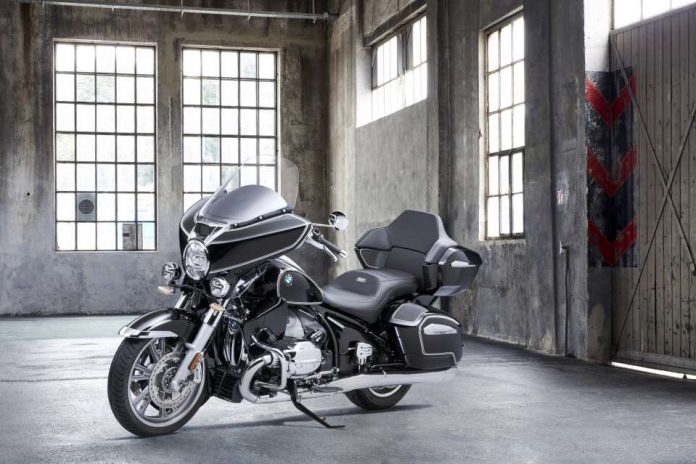


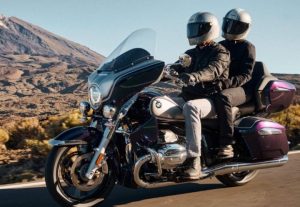
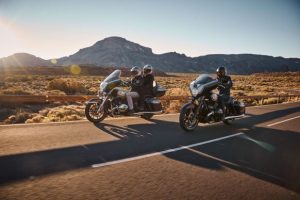
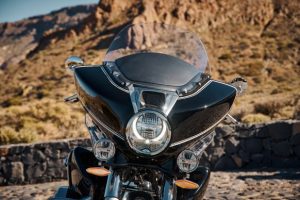
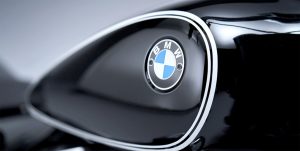








Thanks for the reviews of this, Eric. Beautiful bike visually, but I suspect it will rest within the adage that you do not want to own most BMWs that are not under warranty. I can’t imagine the difficulty and cost of getting parts for this in 25 years. Way too much unnecessary complexity for me; I had an simpler R-80 for two decades which I mistakenly sold a few years ago; I’m looking for another. I’d prefer another of those by a long shot before an R-18, even if the prices of the R-18 come down (I hear the prices are falling). I’ve also seen reports that these have objectionable vibration above 50 mph, which if true seems inexcusable. The earlier R-1200C cruiser seems to be considered by many a disappointment; this R-18 suggests BMW learned little from its R-1200C experience.
Hi Bill,
It was my pleasure, literally! I didn’t experience the vibration; the big twin was immensely torquey but also very smooth. The main deficit, I think, is the bike’s weight. It is a massive thing, almost 1,000 pounds before the rider saddled up. Two up, it is a lot of weight. It is not a bike for people who aren’t pretty damned strong, especially upper body but also legs. Low seat height helps, but if it starts to get away from you…
PS: I’m getting the big adventure-touring rig soon!
Nice writeup Eric. How’s the big 2-cyl., vibration wise, on the road?
I owned a GS1250 for a while, and I wasn’t to fond of the power delivery, which was kinda like chug-a-chug (to me). If I was 2-up and needed power, I just wasn’t fond of how it worked.
I am also probably very biased coming from 4-cyl roadracing machines and my current FJR 4-cyl 1300 (smooth as glass). I also own a 2-cyl KTM 790 and it’s much smoother than my experience with the GS.
Thx
Beautiful bike, but boy, sure is expensive!
There are carb conversion packages for milwaukee 8 motors to delete the electronic throttle and injection….I wonder if someone will make a package for this one or at least a throttle cable add on. That’s my only issue though, it is a beauty of a bike!
BMW is one of the few bike makers to be able to incorporate modern tech, while simultaneously paying homage to its heritage. One of the others is Royal Enfield… 🙂
Nice write-up! Certainly makes me want one.
…Heated seats on a bike, it’s hard to even imagine.
Nice bike. When are you going to test the BMW HP4 race? 2.64 diff., 109 mph in 1st gear, you can go to jail in first gear.
https://www.motorbikecatalog.com/auta_details1.php